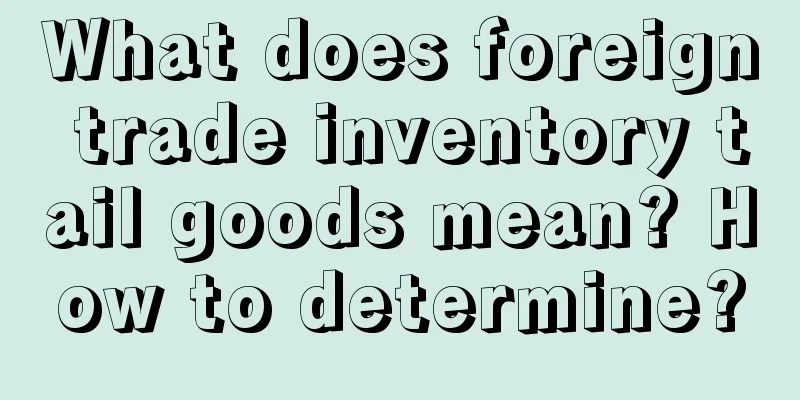What does foreign trade inventory tail goods mean? How to determine?

|
When we buy things online, we will see that some merchants specialize in foreign trade inventory. Some refer to the original brand inventory. So, what does foreign trade inventory mean? 1. What does foreign trade inventory tail goods mean? 1. Tail goods mean: the remaining products after factory returns or orders, or samples, and inventory backlogs. 2. Tail goods are the excess products left after the production is completed and the products are delivered. Some of these products belong to reasonable production losses. As a highly profitable industry, the threshold for clothing is very low, and it has developed too fast in recent years. As a result, supply exceeds demand, and a large number of clothes cannot be sold. Therefore, a large amount of inventory in the warehouses of manufacturers and brand owners has become tail goods, which is the largest source of tail goods. For example: the total production volume of domestic processing enterprises is equal to the subject volume of the contract order plus the reasonable loss agreed by both parties. After delivering the goods according to the contract order volume, the remaining products are called foreign trade tail goods. Generally, they can be handled by domestic production enterprises. 3. Since these are leftover products, domestic processing companies have already earned the profits they deserve by completing orders. In order to reduce inventory backlogs, they often sell them at prices below cost. 2. How to determine the tail goods of foreign trade inventory? 1. Price comparison Foreign trade tail goods usually come from manufacturers. Their business is mainly to produce products for brand owners, not to sell them. Therefore, the price of excess foreign trade tail goods is not high. 2. Quality comparison Foreign trade tail goods are genuine products. Whether in terms of materials or craftsmanship, they are no different from genuine products. The only difference may be a small inconspicuous flaw on a certain product. Most foreign trade tail goods are intact genuine products. However, nowadays, some manufacturers who are good at imitation can produce fakes that are almost indistinguishable from the real thing. When purchasing goods, the store must understand every detail of the genuine product, or compare it with the genuine product. 3. Trademark comparison The biggest difference between leftover foreign trade goods and genuine goods is the label. Some leftover foreign trade goods are labeled at the end, while some leftover foreign trade goods of big brands are not labeled at all. This does not mean that the quality of the goods is bad or they are fake, but it is to protect the genuine goods on the market. Big brands have very strict protection measures for their products. Not only will leftover foreign trade goods not be labeled, but even the brand packaging bags cannot be used. To sum up, foreign trade inventory tailings refer to the products or samples that remain after the factory orders are completed, or the defective products that are returned due to unqualified quality. |
<<: List of cross-border payment institutions
>>: What are some English shopping websites? Website recommendations
Recommend
How to register Shopee with a mainland mobile phone? What is the process?
Shopee is a relatively well-developed cross-border...
618 sales start, Alibaba cancels e-commerce "pre-sale" for the first time
This year's 618 promotion has kicked off. This...
No one can "wake up" Double 12
From shopping sprees and shopping festivals to goo...
Live streaming sales, godfathers everywhere
The live streaming industry is undergoing profound...
Seizing the opportunity of her economy and Valentine's Day, is there a promising future for "e-commerce flowers"?
As living standards improve and young consumers pa...
What does Amazon North America mean? What are the Amazon sites?
Driven by the wave of digitalization, cross-border...
Xiaohongshu local life is coming? Don’t worry! You may be scammed!
As Xiaohongshu gradually expands its layout in the...
How does shopfiy operate? What are the steps?
There are many merchants doing independent cross-b...
Zeng Ming: The most difficult hurdle for a founder is extreme loneliness and self-doubt, but the only thing he can do is believe in himself
Source: Zeng Ming's keynote speech at the West...
Not only reference, the hidden main line of Bawangchaji's rapid growth
How to quickly stand out in a market crowded with ...
3.14 million followers in 3 days, overwhelming traffic hits "grassroots internet celebrity" Guo Youcai
Recently, Guo Youcai has become popular in Heze, S...
Is Lazada Singapore easy to operate? Is Lazada still easy to operate now?
Lazada has six sites, namely Vietnam, Malaysia, Si...
The scientific method to create a Xiaohongshu account only requires 3 steps!
Many people want to create an account on Xiaohongs...
Advertising spending will grow against the trend in 2024!
Why will advertising spending grow against the tre...
Apple forcibly collects "tolls", WeChat and Douyin open up "new routes", and a tough battle is about to begin!
The friction between Apple and WeChat and Douyin i...









